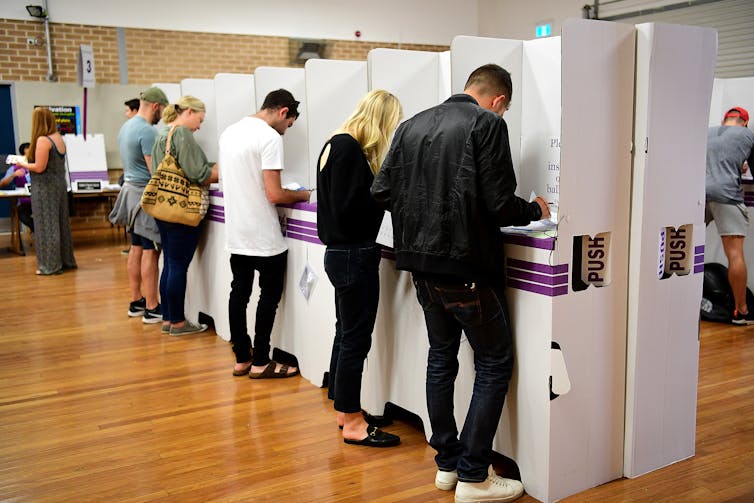
This week’s Newspoll, conducted May 4-7 from a sample of 1,523, gave Labor a 54-46 lead, a one-point gain for Labor since the previous week’s Newspoll. Primary votes were 39% Labor (up one), 35% Coalition (down one), 11% Greens (steady), 5% One Nation (steady), 4% UAP (steady) and 6% Others (steady).
55% were dissatisfied with Scott Morrison’s performance (up four) and 41% were satisfied (down three), for a net approval of -14, down seven points. Anthony Albanese’s net approval improved three points to -6. Morrison led as better PM by 44-42 (45-39 last week).
Labor led the Coalition by 44-41 as best to handle cost-of-living pressures; this lead is narrower than in other polls that have asked this question. Newspoll figures are from The Poll Bludger.
The Reserve Bank on May 3 raised the cash rate by 0.25% to 0.35%, the first time it has increased in more than 11 years. It’s virtually certain that this rate hike is the first in a series that will continue in the coming months.
I believe both this rate hike and the ABS inflation report the previous week have had an impact on the polls. Voters hate seeing prices rise for food and petrol, and this matters far more than whether Albanese forgot his NDIS policy.
In last week’s report, I said Morrison’s net approval in Newspoll had improved five points to -7, and the Coalition could win if he improved to near net zero. But he’s slumped seven points to -14 now.
All current polls have moved towards Labor. With early voting beginning Monday and just 12 days until the election, it is becoming increasingly likely that Labor will win.
Ipsos: 57-43 to Labor
An Ipsos poll for The Financial Review, conducted May 4-7 from a sample of 2,311, gave Labor a 57-43 lead, a two-point gain for Labor since last fortnight. Primary votes were 35% Labor (up one), 29% Coalition (down three), 12% Greens (steady), 4% One Nation (steady), 3% UAP (steady), 10% Others (up two) and 7% undecided (down one).
Labor led by 52-40 by 2019 preference flows (50-42 previously) – the headline figure excludes undecided. By respondent allocated preferences, Labor led by 50-35 (48-38 last time).
51% disapproved of Morrison’s performance (up three) and 32% approved (down two), for a net approval of -19, down five points. Albanese’s net approval was down two points to -6. Albanese led by 41-36 as preferred PM (40-38 previously).
Read more: Race for the Senate: could Labor and the Greens gain control?
Impact of how to vote cards is exaggerated
Analyst Kevin Bonham wrote last December that changes in relative major party primary votes are a far bigger factor in recent Australian elections than minor party preferences. Labor relies far more on preferences than the Coalition to win seats, such as from the Greens.
Had UAP preferences split evenly between the major parties in 2019, rather than 65-35 to the Coalition, Labor would have won just one extra seat: Bass, and the Coalition would still have governed.
The main purpose of how to vote cards is to reduce the informal rate by giving a party’s voters something they can easily copy. If the UAP’s how to vote card made a 10% difference in its preference flow, then 5% of the vote would be required to produce a 0.5-point difference in the final two party vote. This only matters in very close seats.

Labor’s lead increased in last week’s Essential and Morgan polls
In last week’s Essential poll, conducted April 27 to May 1 from a larger than normal sample of 1,500, Labor led by 49-45 with undecided included (47-46 in mid-April). Primary votes were 36% Coalition (down one), 35% Labor (steady), 10% Greens (up one), 4% UAP (steady), 3% One Nation (steady), 5% all Others (steady) and 6% undecided (down one).
33% (down one since mid-April) said the government deserved to be re-elected, while 46% (down two) said it was time to give someone else a go. 79% said cost of living was important or very important, and Labor was trusted to manage this by 40-30 over the Coalition.
47% (up five since last October) said Australia was not doing enough to address climate change, while 32% (up one) said we were doing enough and 11% (down four) that we were doing too much.
A Morgan poll, conducted April 25 to May 1 from a sample of 1,487, gave Labor a 55.5-44.5 lead, a one-point gain for Labor since the previous week. Primary votes were 35% Coalition (down 0.5), 35% Labor (steady), 13% Greens (up one), 3% One Nation (down 1.5), 1% UAP (down 0.5), 9.5% independents (up 1.5) and 3.5% others (steady).
Seat polls: Goldstein, Mackellar, Boothby and ACT Senate
The usual warning for seat polls applies: they are unreliable, particularly those for partisan groups.
A uComms poll of Goldstein (Vic) for the left-wing Australia Institute gave independent Zoe Daniel a 62-38 lead over Liberal incumbent Tim Wilson, though this was 57-43 using 2019 preference flows. Primary votes were 35% Wilson, 34% Daniel, 14% Labor and 8% Greens. This poll was done April 27 from a sample of 855.
The Poll Bludger reported that a uComms poll of Boothby (SA) for the SA Forests Products Association gave Labor a 55-45 lead over the Liberals (51.4-48.6 to Liberal in 2019). This was conducted May 4-5 from a sample of 810.
A Redbridge poll of the ACT Senate for Climate 200 gave Labor 27% (39% in 2019), the Liberals 25% (32%), independent David Pocock 21% and the Greens 11% (18%). This suggests tactical voting by Labor and Greens to stop the Liberals taking the second ACT Senate seat (they only need 33.3% after preferences). This poll was done April 23-24 from a sample of 1,064.
Read more: Race for the Senate: could Labor and the Greens gain control?
A uComms poll of Mackellar (NSW) for the campaign of independent Sophie Scamps gave incumbent Liberal Jason Falinski 32% of the primary vote (down three since a similar poll a month ago), Scamps 31% (up seven), Labor 15%, the Greens 9%, UAP 3%, One Nation 3% and undecided 7%. Scamps would win easily from these primaries. This poll was taken May 4 from a sample of 834.
SA Labor’s coup in upper house
I wrote last week that Labor holds nine of the 22 SA upper house members, the Liberals eight, the Greens two, SA-Best two and One Nation one. In SA, the upper house president only has a casting vote to break a tie.
Had Labor taken the presidency, they would have had eight of 21 votes on the floor, and likely required both the Greens and SA-Best to pass legislation opposed by the Liberals, although One Nation with either the Greens or SA-Best would also suffice.
But Labor installed Liberal Terry Stephens as upper house president on May 3 when the SA parliament first met following the March 19 election. Stephens had been forced to resign as president in July 2020 owing to alleged misuse of parliamentary allowances.
As a result, Labor now has nine of 21 floor votes, and requires just two more to pass legislation. Either the Greens or SA-Best will be sufficient.
Tasmanian upper house elections
Every May two or three of Tasmania’s 15 upper house seats are up for election. This year’s regular elections were in Elwick and McIntyre, and there was also a byelection in Huon. On Saturday, Labor and independent incumbents easily retained Elwick and McIntyre respectively with over 50% of first preferences.
In Huon, which Labor is defending, Labor had 25.2%, a conservative independent 23.9%, the Liberals 22.8%, the Greens 20.3% and the Local party 7.7%. Preferences will decide this seat, but are unlikely to be known until the last day to receive postals on May 17.
UK local and Northern Ireland elections
I live blogged Thursday’s UK local and Northern Ireland elections for The Poll Bludger. The Conservatives received a bloody nose, but their losses did not go to Labour, but to the Lib Dems and Greens. In Northern Ireland, the Irish nationalist Sinn Féin became the first nationalist party to win a plurality of votes and seats, but the unaligned Alliance was the biggest winner.
Adrian Beaumont does not work for, consult, own shares in or receive funding from any company or organisation that would benefit from this article, and has disclosed no relevant affiliations beyond their academic appointment.
This article was originally published on The Conversation. Read the original article.







